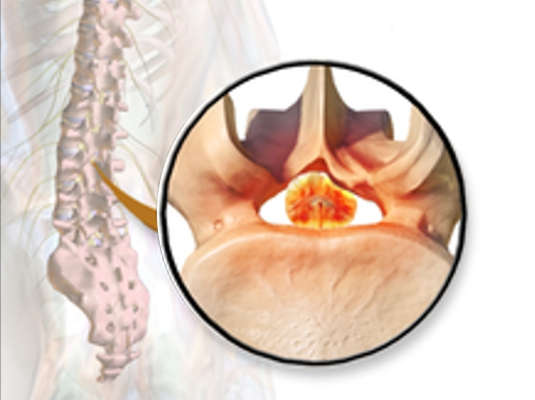Spinal stenosis refers to a condition in which the passageways between the vertebrae that reduced in size. This can include the spinal canal, a vertical “tunnel” through which the spinal cord passes, or the foramen, which are the horizontal passageways naturally created by the vertebrae which nerves pass through. The pressure placed o the spinal cord and on nerve roots can lead to painful nerve compression, one of many sources of back pain.

One of the main symptoms of spinal stenosis is that patients often experience more pain standing and walking, but significantly less or no pain while sitting or bending forward. This is due to the fact that, when the spine is rounded as in sitting or bending, it is extended and creates more space for the nerves within, temporarily de-compressing them. Because the nerves in the spine radiate out and extend to the rest of the body, leg pain is also a common symptom of lumbar (lower back) spinal stenosis.
Spinal stenosis is usually a result of age-related wear on the spine. It can also be caused by injury or degenerative disease such as osteoporosis. Some people are more prone to spinal stenosis than others. Spinal stenosis usually occurs in the cervical (upper) or lumbar (lower) spine.
Arabic-speaking patients: please have a look at this video in which Dr. Kohler, top spine surgeon at Asklepios Westklinikum, explains the causes, symptoms and treatments of spinal stenosis.
Treatment options for spinal canal stenosis
Spinal stenosis can be treated with:
- Conservative treatment – physical therapy and exercisecan lead to improvement of symptoms of spinal canal stenosis. Many patientss of Premier Healthcare Germany travel to Germany for a short, intense conservative treatment program involving physical therapy and exercises to do at home. This may involve the patient learning techniques for how to walk, sit or lift to avoid aggravating the condition. With good compliance, most patients experience significant improvement.
- Injections and medication – a steroid injection near the nerve roots in the spine can reduce inflammation and pain. In addition, certain muscle relaxants, anti-inflammatory medication and pain relief medication may provide relief of symptoms associated with spinal canal stenosis.
- Surgery - if conservative treatments are not working or the patient's condition gets significantly worse, surgical intervention may be necessary.
Treating spinal stenosis with surgery
There are two main types of surgery to treat spinal stenosis: stability and decompression.
Stability surgery refers to a technique, such as spinal fusion, that stabilizes vertebrae and prevents them from moving. For types of stenosis where movement causes pain, this may be a good treatment option because it could hold the vertebrae in a position where they will not compress nerves.
Decompression surgery involves making more space for the nerves so they are no longer compressed. This can involve one or many techniques, including:
- Foraminotomy, in which the horizontal passageways in the vertebrae are widened#
- Laminotomy, in which the vertical passageways in the vertebrae are widened, or
- Laminectomy, in which the bony plate surrounding the spinal canal is completely removed.
All of these techniques can be performed alone or in combination with each other.
As with all major surgeries, there are certain risks involved. Complications may include infection, failure to improve, or injury to the spinal cord or nerves.
How we can help
Premier Healthcare can connect patients with highly-qualified German doctors to provide patients with the most accurate diagnoses and best treatment recommendations. We have relationships with several major hospitals in Germany and are experienced at guiding international patients through the German healthcare system. Some of the hospitals in our network have centers and departments specifically focused on treatments for the spine, where patients can be assured they will be treated by specialists with years of professional experience.
To find out more about treatment options in Germany for conditions of the spine, contact us.
